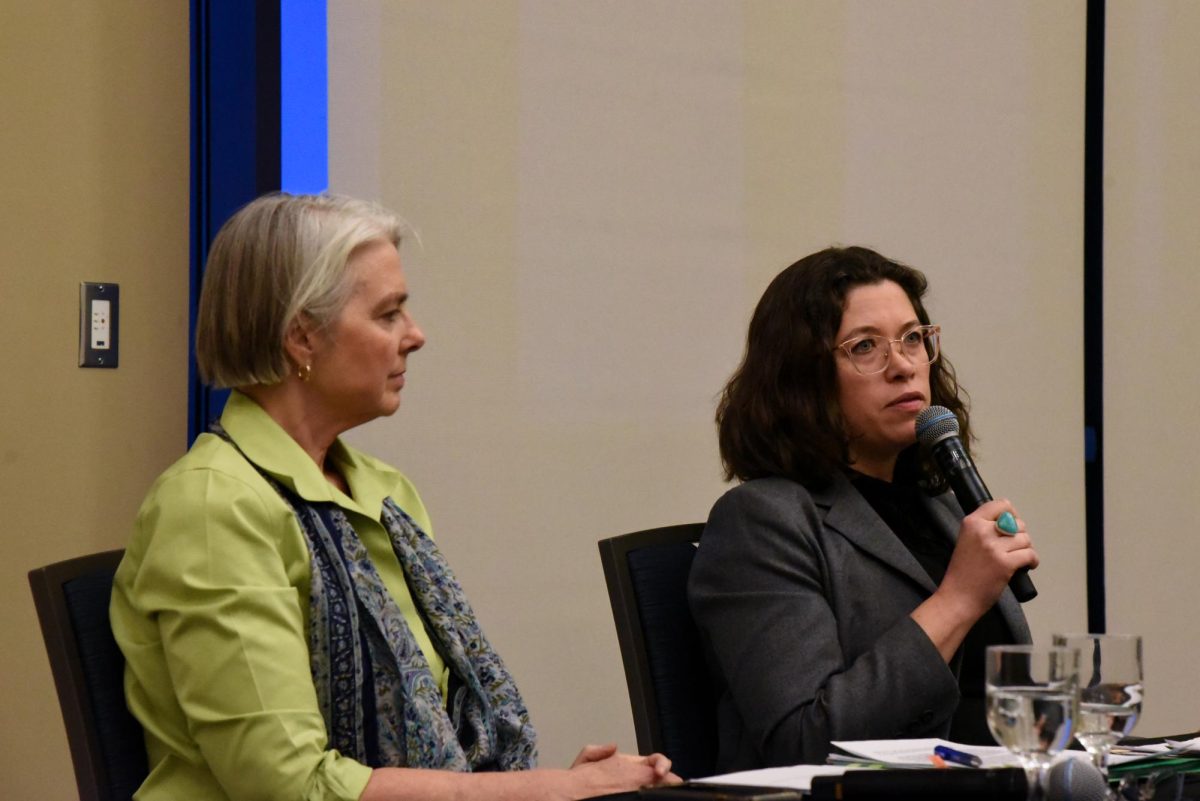The beautiful UVM campus and genuinely nice people make Burlington the ideal place to learn and grow. But the protective bubble of safetey often thought to surround this quaint townmight not be as secure as many students believe. Considering the unprecedented campus crimes of the last two months – the tragic abduction and murder of Michelle Gardner-Quinn and Colby Eck’s assaults on Harris residents – it’s no wonder that students, especially women, are changing the way they think about their daily activities. “It’s definitely made me think twice about walking downtown by myself … I’m more cautious now,” 18-year-old UVM freshman Cindy Conquest said. “If I can avoid walking alone, I will. It’s our time to be independent, but then people are saying ‘don’t go anywhere alone.'” For other women, the mental and psychological impacts from the crimes loom larger than daily life. “My daily activities haven’t changed that much; it’s in what I’m thinking,” said 17-year-old psychology major Emily Crofton. “I second guess things now. I’m more alert than before.” Julie Camuso, a UVM freshman from Hamilton-Wenham, Mass. agrees. “I’m less outgoing with people I’ve never met before; now I hold back a lot … and now people that were typically not sketchy before are sketchy now,” Camuso said. Indeed, Burlington’s bubble has, in the past, sheltered its inhabitants from violent crimes like those that have occurred in the past months. This town is thought of as a secure haven for many students who fall into routines where safety and alertness tend to drift to the back of the mind. “I was shocked [after the crimes], because in my experience, Burlington is typically really safe; nothing bad ever really happens,” Lucas Faryniarz, Resident Advisor of Millis 4 High said. “These events were so out of place, and both events happened so close together.” Many students feel that because there is so little violent crime in Burlington, the impact, when it does occur, is compounded. “It’s not like it’s completely unexpected at college. I think it’s a problem most other colleges have because you can’t avoid things like that,” Conquest said. There is a kind of invincibility that traditionally comes with being a young, newly independent college student and recent events have shaken that notion. But even with these crimes still at the forefront of the community’s mind, some students aren’t so quick to change their opinion on the town’s safety. “My view of Burlington hasn’t really changed” Faryniarz said. “Burlington is still safe, and UVM is a safe campus. Obviously some events happen every once in a while that are going to try to prove it false. “Just the fact that these crimes have garnered so much attention shows how out of place they are. We’re striving to make the campus safe, and it says a lot about how safe the city and campus are,” he said. Although there are many ways the University tries to protect its students, the success of these safety measures relies heavily on the student body itself. For instance, Harris/Millis has only 16 RAs, who have been adding extra rounds to their routines, but cannot monitor the two dorms all the time. “The residents have to be cautious and safe,” Faryniarz said. “Travel in groups, not just girls, but guys too; this can happen to anybody. Just do those little things that can make your experience safe and, in the end, benefit you.” Even with police services close to the dorms, Faryniarz believes that it’s the residents’ job to bring problems to their RA. “Basically, at this time you can’t be too safe, and there’s always someone on call to help, he said.” Although the police can help the students to the best of their abilities, it is not solely their responsibility. “It’s a combination of them and us,” Conquest said. “A lot of the problems in dorms can be avoided if students are smarter; hopefully we can avoid things like this in the future.” Gary Margolis, Chief of UVM Police agrees. “The incidents that involved drug-induced violent behavior were the result of people who were in the residence halls as guests of others and not the result of an inadequate residence hall security measure, he said. “I can’t think of any security measures that could work at UVM that wouldn’t be easily bypassed by student complacency.” Another easily recognizable but often misused safety feature are the approximately 115 blue light stations scattered throughout campus. “I can’t recall the last time a blue light was activated for a real emergency as opposed to a prank,” Margolis said. “They’re dispersed through campus at strategic locations chosen based on analysis of foot traffic, area of campus, lighting, etcetra” he said. “Every blue light is visible from at least one other blue light. This allows someone in need of help the opportunityto run from one to the other if they have to. “Police response is as fast as possible given traffic patterns and location of the officer on campus. We can typically get to any 911 call … within minutes.” Margolis also explained some of the ways that students can continue being safe. “We can all protect ourselves by maintaining situational awareness of what’s going on around us, making good decisions to minimize risk to ourselves and those we love, and continuing to engage men in the conversation about how our society promulgates a culture that feeds into violence against women.” However, many students feel that there are additional measures the University could take to help protect its students, especially regarding buses and safe rides. “The bus situation is very ridiculous – everything I’ve heard is different,” Camuso said. “More access to information and public transportation could help avoid a lot of problems,” Camuso said. “Also, there should be non-police safe rides to help students get home, while avoiding getting other people in trouble,” she said. “We shouldn’t have to call campus police; it’s so extreme. “I don’t know many people who would feel comfortable doing that, and I see no reason why we should be uncomfortable in such an ordinary situation,” she said. Beyond the tragic aspects of these crimes lies the frightening fact that Gardner-Quinn and the women assaulted by Eck were ordinary people in ordinary situation, Camuso said. “It could have been anybody,” Crofton said. “It’s not like [Michelle] did anything out of the ordinary and stupid that we’re like, ‘I’d never do that.'” Eck’s attacks and the Gardner-Quinn tragedy have also exposed the vulnerability of women on campus. “Since it hits so close to home, it has an impact on us, but we hear about these kind of things all the time,” Crofton said. “I feel like we take for granted living in a safe community,” Camuso said. “Even though these things are startling, disturbing, and horrible, it’s a wake-up call, not just for Burlington, but for anyone who goes to college anywhere. “One thing that really bothers me because it’s so stupid and so absolutely outrageous,” Camuso continued, “Is that we as women have to choose between two things that we don’t want to do, like walking alone or using a stranger’s phone. We shouldn’t have to feel [unsafe].” Although tragic, these crimes may have a positive effect: an increased awareness about women’s safety and the ability to prevent these kinds of crimes in the future. With student groups creating initiatives across campus, the community can take control and react positively to these crimes with education and awareness. President Fogel recently sent an e-mail to UVM students and faculty regarding Men Advocating Change’s distribution of white ribbons to individuals pledging never to commit violence against women. “We all have a stake and responsibility in seeking an end to the epidemic of violence against women,” the e-mail stated. For Camuso, this means a lot. “This is the most important and comforting thing they can do. They’re easing fear so we don’t feel uncomfortable … they’re doing something about it,” she said. Initiating a dialogue between women and men regarding violence is also important to Margolis. “The vast majority of men are not rapists, and the vast majority of men are not engaged in the conversation about how they can help prevent violence against women,” he said. “I also recognize that we spend a lot of time talking with women about violence prevention but not to the people who commit the violence: men.”












